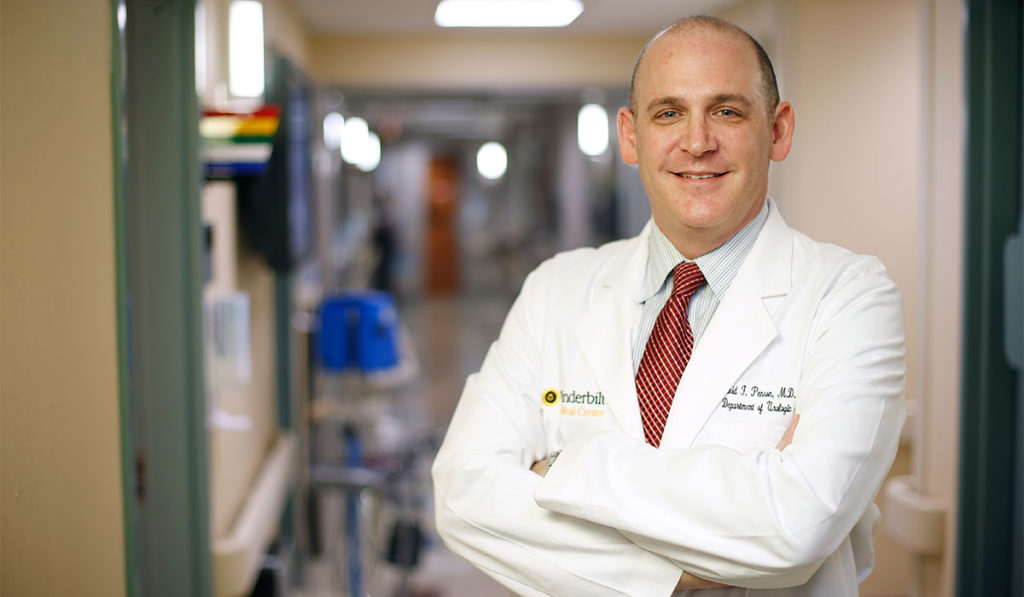As the former public policy chair and chair-elect for the Science & Quality Council of the American Urological Association (AUA), David Penson, M.D., is at the forefront of debates over screening for prostate cancer.
Listen to an audio interview with David Penson about the USPSTF screening guidelines.
Discoveries: Before we discuss the current 2017 draft of the USPSTF PSA screening guidelines (final recommendation here), would you explain the background?
Penson: This has been a really interesting and highly debated area in healthcare policy, and it’s been going on for years. There has been a general feeling among PCPs and specifically family practitioners that there’s not a lot of value to prostate cancer screening. Conversely, when you talk to cancer specialists, urologists and medical oncologists, there’s a feeling that screening saves lives.
Prior to 2012, there was a lot of uncertainty. The USPSTF is the main government body that makes recommendation to PCPs regarding preventive measures. The USPSTF is made up of PCPs, evidence-based medicine specialists and some epidemiologists. They don’t allow any specialties. And until 2012, they never made a strong recommendation about screening. They gave it an “I,” or “indeterminate,” because there was no randomized clinical trial data showing a benefit one way or the other.
Discoveries: What evidence was USPSTF considering at that time?
Penson: In the late naughts, two studies came out examining screening, one from Europe — the European Randomized Study of Screening for Prostate Cancer (ERSPC) — and one from the United States — the Prostate, Lung, Colorectal and Ovarian (PLCO) Cancer Screening Trial. The PLCO study was a negative study. It didn’t show a benefit to screening. If you want my opinion, the study was flawed. But the USPSTF took it at face value, in no small part because there were no specialists on the committee to help them understand the nuances. The ERSPC study, the European study, was a positive study. It showed a small benefit to screening.
In 2012, the USPSTF looked at those data and at the harms of prostate cancer treatment and said, “We shouldn’t be screening. We’re giving it a grade ‘D’.” That made for an incredible outcry on the part of patient groups — patient advocacy groups and specialty groups — saying, “You know, you’re hurting men and you’re not really thinking this through.” Groups including the AUA came out with their own guidelines recommending shared decision making — letting the individual patient understand the pros and cons and make their own choice. That was the position of the AUA, the American Society of Clinical Oncology (ASCO), the American College of Physicians — pretty much all groups except for the USPSTF and the American Academy of Family Physicians (AAFP).
Discoveries: How were you involved in that debate on behalf of the AUA?
Penson: That was when I was chair for public policy. We felt as though something had to be done about the recommendation. But it was difficult to move the battleship. The AUA and some other specialty societies partnered with the patient advocacy groups and went to Congress. I testified in front of Congress about the fact that USPSTF didn’t have specialists giving them advice. In any event, the grade “D” recommendation stood for five years.
Here at Vanderbilt, we did some research, published in the Journal of Urology, that showed a decline in PSA screening in response to the USPSTF recommendations. It also showed a drop in the incidents of prostate cancer. We were catching less prostate cancer. And, unfortunately, we were catching less high-risk prostate cancer. The Vanderbilt study and others like it were influential in mobilizing the patient community, other physicians and specialists to push back against the grade “D” recommendation.
Discoveries: What else happened to influence the USPSTF recommendation?
Penson: The USPSTF decided to revisit its recommendation in 2017, as they do every five years. They reached out to the specialty societies and asked for input — quietly, because they weren’t going to put a specialist on the panel. I represented the AUA and gave them input, behind the scenes, trying to guide them to the right studies showing that PSA testing is more nuanced than a straight grade “D.”
Last year, in what I take as a victory for everyone, the USPSTF changed its recommendation from a “D” to a “C.” A “C” recommendation means that you should discuss the pros and cons of screening with the patient and let him make his own individual choice. That brings the USPSTF into alignment with most every specialty group, with the exception of the AAFP.
Discoveries: As a urologist who was in conversation with the USPSTF and Congress, what are the major concerns about PSA testing?
Penson: f you go back to the original grade “D” recommendation, the task force acknowledged a benefit to screening, but they felt the harms outweighed the benefits. There is something to that; there are real harms associated with screening. The PSA test is a fine test, but it’s not very specific. You will get false positives because of enlarged prostates, or prostate infections, and that will lead to a biopsy. There is a risk of infection and of going into urinary retention. But the real risk comes when someone is diagnosed with prostate cancer. Probably one-third to 40 percent of patients who are diagnosed with prostate cancer due to PSA testing are overdiagnosed, which means the cancer will not have a clinical effect on them for the rest of their lives.
In the past, urologists didn’t have a good feel for who had an overdiagnosed cancer, so we would treat everybody. In 2012, the USPSTF looked at that and said, “Well, in the end, if you treat an overdiagnosed cancer, you’re doing more harm than good.” What changed? One, the USPSTF got additional data showing that screening helps more men than originally thought, in ways other than just survival. For example, screening avoids metastatic prostate cancer. That wasn’t considered in 2012.
The other thing that has changed is a credit to doctors who treat prostate cancer across the country, whether they are a urologist or radiation oncologist. We’ve started using active surveillance instead of aggressively treating patients with low-risk cancer. We’ve identified, to some degree, which patients are more likely to have an overdiagnosed cancer. Instead of rushing right to an operating room or a radiation vault, we’re doing more targeted biopsies. We’re following them with PSAs. That changed the math.
Discoveries: Within the model of shared decision making that the USPSTF is proposing to recommend, would you like to see any refinements to the guidelines?
Penson: I don’t expect USPSTF to get into that because they’re a primary care panel. It’s incumbent on urologists, medical oncologists, radiation oncologists and physicians who are treating patients with prostate cancer to identify new ways to screen and more accurate ways to screen.
This is one of the areas where the future is interesting and exciting. Look at the many new technologies and tests being developed. In the future, you may get a prostate MRI together with a PSA to decide whether to go further down the screening cascade — or another blood test like a 4Kscore, or a Prostate Health Index score, or any number of any new biomarkers being developed. I think groups like the AUA, the American Society for Radiation Oncology and ASCO will update their guidelines to explain better ways to screen beyond just a simple PSA test.
When we reach that point of showing that the benefits of screening greatly outweigh the harms, I hope USPSTF will change its recommendation from shared decision making to an “A” or a “B,” which will say, “Here’s how you want to do this. You want to get this test and this test.” If your risk is low, you may get screened every five years. If your risk is high, you may get screened every year, similar to colon cancer screening.
Discoveries: What is your view about the demographic or age groups that are most appropriate for testing?
Penson: The studies have looked at men with “normal risk.” We don’t know enough about how to screen in men with high risk: men who are African American, men who have a strong history of prostate cancer. In men at normal risk, the recommendation starts at age 50 to 55 and stops around age 70, when a patient has less than a 10-year life expectancy.
I wonder if there are ways to better understand risk. Some studies have looked at a single PSA for a man in his 40s. If it’s above 1.5, that greatly increases his risk of dying of prostate cancer, so we should screen more. If it’s less than 1.5 at age 45, your risk is much lower, so you probably should be screened less, if at all.
Discoveries: What new areas of prostate cancer screening are exciting?
Penson: Two areas are really exciting. First is prostate imaging. We’ve come a long way in understanding how to look at the prostate to identify tumors. Vanderbilt is on the cutting edge for prostate cancer MRI, and now we’re getting there for nuclear medicine imaging. For a patient who has an elevated PSA but is reluctant to undergo a biopsy, a prostate MRI is a very good test to rule out prostate cancer. We have dedicated radiologists who just do GU and prostate imaging, so that’s a real advantage and we’ve done studies in that space.
The other exciting area is around biomarkers. We have a number of FDA-approved biomarkers, including the free-to-total PSA, which has been around for some time. The 4Kscore, which is FDA-approved, really helps identify a patient’s risk. We have a number of studies ongoing for biomarkers that are not currently FDA-approved. So if a patient has an elevated PSA and is reluctant to have a biopsy, we probably have a study for them.
Discoveries: Thank you and congratulations on your new role as chair of the AUA Science & Quality Council.
Penson: Thank you.





